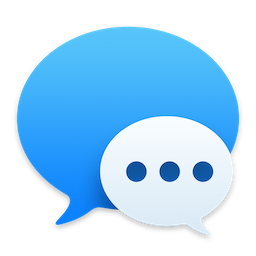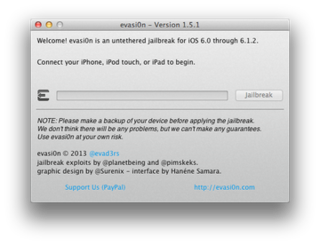
Privilege escalation is the act of exploiting a bug, a design flaw, or a configuration oversight in an operating system or software application to gain elevated access to resources that are normally protected from an application or user. The result is that an application with more privileges than intended by the application developer or system administrator can perform unauthorized actions.

The iPod Touch is a discontinued line of iOS-based mobile devices designed and marketed by Apple Inc. with a touchscreen-controlled user interface. As with other iPod models, the iPod Touch can be used as a music player and a handheld gaming device, but can also be used as a digital camera, a web browser and for messaging. It is similar in design to the iPhone, but it connects to the Internet only through Wi-Fi and does not use cellular network data, so it is not a smartphone.

iOS is a mobile operating system developed by Apple Inc. exclusively for its hardware. It is the operating system that powers many of the company's mobile devices, including the iPhone; the term also includes the system software for iPads predating iPadOS—which was introduced in 2019—as well as on the iPod Touch devices—which were discontinued in mid-2022. It is the world's second-most widely installed mobile operating system, after Android. It is the basis for three other operating systems made by Apple: iPadOS, tvOS, and watchOS. It is proprietary software, although some parts of it are open source under the Apple Public Source License and other licenses.
SpringBoard is the standard application that manages the iPhone's home screen. Other tasks include starting WindowServer, launching and bootstrapping applications and setting some of the device's settings on startup.
On Apple devices running iOS and iOS-based operating systems, jailbreaking is the use of a privilege escalation exploit to remove software restrictions imposed by the manufacturer. Typically it is done through a series of kernel patches. A jailbroken device permits root access within the operating system and provides the right to install software unavailable through the App Store. Different devices and versions are exploited with a variety of tools. Apple views jailbreaking as a violation of the end-user license agreement and strongly cautions device owners not to try to achieve root access through the exploitation of vulnerabilities.

Cydia is a graphical user interface of APT for iOS. It enables a user to find and install software not authorized by Apple on jailbroken iPhones, iPads and iPod Touch devices. It also refers to digital distribution platform for software on iOS accessed through Cydia software. Most of the software packages available through Cydia are free of charge, although some require purchasing.

Installer.app was a freeware software installer for the iPhone created by Nullriver and later maintained by RipDev, first released in summer 2007 and maintained until summer 2009. Installer allowed users to install third-party applications into the iPhone's Applications directory where native applications are kept. Users could install applications from a variety of sources provided by software developers or directly onto the iPhone without requiring a computer. Users could browse lists of applications inside Installer to find ones they wanted to install. In June 2009, RipDev dropped support for Installer in favor of developing a different package manager and installer named Icy.
blackra1n is a program that jailbreaks versions 3.1, 3.1.1 and 3.1.2 of Apple's operating system for the iPhone and the iPod Touch, known as iOS.

iOS 4 is the fourth major release of the iOS mobile operating system developed by Apple Inc., being the successor to iPhone OS 3. It was announced at the Apple Special Event on April 8, 2010, and was released on June 21, 2010. iOS 4 is the first iOS version issued under the "iOS" rebranding, dropping the "iPhone OS" naming convention of previous versions. It was succeeded by iOS 5 on October 12, 2011.

Jay Ryan Freeman is an American businessman and software engineer. He is known for creating the Cydia software application and related software for jailbroken iOS—a modified version of Apple's iOS that allows for the installation and customization of software outside of the regulation imposed by the App Store system.
A SHSH blob is an unofficial term referring to the digital signatures that Apple generates and uses to personalize IPSW firmware files for each iOS device. They are part of Apple's protocol designed to ensure that trusted software is installed on the device, generally only allowing the newest iOS version to be installable. Apple's public name for this process is System Software Authorization.
greenpois0n is a name shared by a series of iOS jailbreaking tools developed by Chronic Dev Team that use exploits to remove software restrictions on iPhones, iPads, iPod Touches, and Apple TVs. Greenpois0n's initial release in October 2010 jailbroke iOS 4.1, and its second version in February 2011 jailbroke iOS 4.2.1 as well as iOS 4.2.6 on CDMA iPhones. The second generation of the tool, greenpois0n Absinthe, was developed with iPhone Dev Team members and jailbroke iOS 5.0.1 in January 2012, and a second version jailbroke iOS 5.1.1 in May 2012.

iMessage is an instant messaging service developed by Apple Inc. and launched in 2011. iMessage functions exclusively on Apple platforms: macOS, iOS, iPadOS, and watchOS.

Evasi0n,, is a untethered jailbreak program for iOS 6.0 - 6.1.2 and for iOS 7.0 - 7.0.6. It is known for a portable code base and minimal use of arbitrary code execution. More than seven million copies of Evasi0n were downloaded and presumably installed in the first four days after release. It was released on 4 February 2013. Four of the six exploits used were patched by Apple on 18 March 2013 with the release of iOS 6.1.3, which meant the end of the original version of evasi0n. On 22 December 2013, the evad3rs released a new version of evasi0n that supports iOS 7.x, known as evasi0n7. One major exploit used by this jailbreak was patched by Apple with the 4th beta of iOS 7.1 and two more with beta 5. The final release of iOS 7.1 fixed all the exploits used by evasi0n7.
The Pangu Team, is a Chinese programming team in the iOS community that developed the Pangu jailbreaking tools. These are tools that assist users in bypassing device restrictions and enabling root access to the iOS operating system. This permits the user to install applications and customizations typically unavailable through the official iOS App Store.

iOS 9 is the ninth major release of the iOS mobile operating system developed by Apple Inc., being the successor to iOS 8. It was announced at the company's Worldwide Developers Conference on June 8, 2015, and was released on September 16, 2015. It was succeeded by iOS 10 on September 13, 2016.
PP Jailbreak, also commonly known as PP, PP25 App or PP25 Jailbreak, is a term describing a free Chinese app containing tools capable of jailbreaking iOS 8 devices, except for Apple TV. Eligible products include: iPod Touch, iPhone and iPad. This app was developed by a Chinese iOS hacking community known as PP Assistant. It was first released on January 19, 2015

iPadOS 13 is the first major release of the iPadOS mobile operating system developed by Apple Inc. for their iPad line of tablet computers. The successor to iOS 12 on those devices, it was announced at the company's 2019 Worldwide Developers Conference (WWDC) on June 3, 2019, as a derivation from iOS, with a greater emphasis on multitasking and tablet-centric features. It was released on September 24, 2019. It was succeeded by iPadOS 14, released on September 16, 2020.
The iOS mobile operating system developed by Apple Inc. has had a wide range of bugs and security issues discovered throughout its lifespan, ranging from security exploits discovered in most versions of the operating system related to the practice of jailbreaking, as well as bypassing the user's lock screen, to issues relating to battery drain, to crash bugs encountered when sending photos or certain Unicode characters via text messages sent through the Messages application, and general bugs and security issues later fixed in newer versions of the operating system.

iPhone and iPod Touch models released between 2007 and 2009 used system on a chip (SoC) circuits designed by Samsung and manufactured to Apple's specifications. Two such SoCs were used: the Samsung S5L8900, used in the first-generation iPhone, the iPhone 3G, and the first-generation iPod Touch, and the Samsung S5L8920, used in the iPhone 3GS and the third-generation iPod Touch. Both chips belong to Samsung's S5L family of SoCs.












